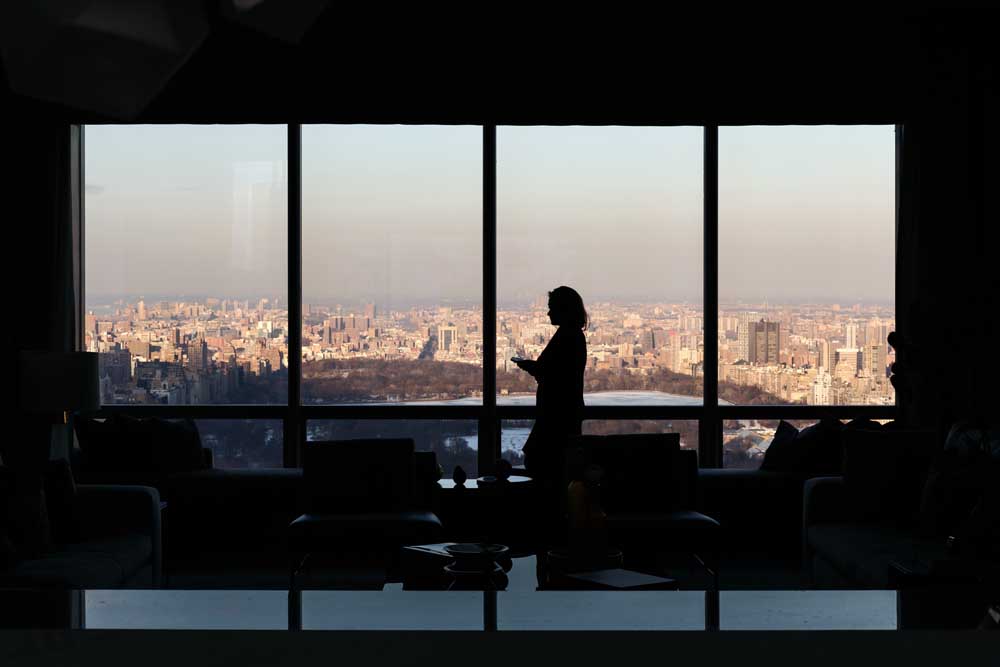Spending a night in one of New York’s tallest apartment buildings
Published 12:00 am Sunday, February 25, 2018

- The One57 condo building in New York was the first of the so-called supertalls, and has made some records since it was topped off in 2012. It has also drawn criticism from its neighbors. (Peter Garritano/The New York Times)
NEW YORK — Recently, I spent the night in one of Manhattan’s most notorious buildings.
One57, the glistening blue funnel that was the first of the skyscraper condominiums — the so-called supertalls — to appear along West 57th and beyond, has made some records since it was topped off in 2012: for the most expensive apartment sold in Manhattan (nearly $100.5 million); for (perhaps) the first apartment bought by a toddler (a Chinese 2-year-old whose mother said she wanted her to have a nice place to live when her daughter attended New York University or Columbia); for the city’s largest foreclosure; and for the highest price paid for an apartment in foreclosure. (The original owner was, reportedly, a Nigerian businessman who was implicated in a money-laundering scheme that included the apartment, a penthouse on the 79th floor for which he had paid $50.9 million; in November, its mortgage holder unloaded it at auction for just over $36 million.)
It was not the first building to tempt foreign buyers as a place to park their cash, but it has been popular for the practice, and for pioneering what is euphemistically called “aspirational pricing.” One57 was also the first of the supertalls to be hit by a correction, as recent resales have traded for 25 percent less than their peak in 2014, according to research compiled late last year by Jonathan Miller of Miller Samuel, the residential real estate appraisal firm.
It was the first residential building here to clear 1,000 feet, through a merging of zoning lots and the purchase of air rights in a wincing calculus that enrages preservationists, many of whom are clamoring for a revision of the city’s outdated zoning laws. For a few months, it was the tallest apartment building in the city, until 432 Park breached nearly 1,400 feet.
Slammed by architecture critics — “chintzily embellished,” wrote Michael Kimmelman in The New York Times, who likened its tinted glass panes to age spots — and loathed by many of its neighbors, particularly those forced to evacuate when its crane collapsed during Hurricane Sandy, One57 has had so much opprobrium heaped upon it that I half-expected to be pelted with eggs the night I arrived for my sleepover. For his part, developer Gary Barnett is proud of his building, and accustomed (sort of) to its lousy reviews. “I think the building is beautiful,” he said.
I had hoped to be lent an apartment on a high floor — 87, say, which is undecorated and quite raw, and on the market for $67 million. There, I envisioned myself with an air mattress and a six-pack, in a night of dizzying anomie.
Instead, Anna LaPorte, the building’s publicist, offered 61B, a three-bedroom listed for $29 million that had been decorated by Jeffrey Beers (the furnishings and embellishments, which cost $2.5 million, are included in the price).
“It’s still 600 feet above Central Park,” she said soothingly.
I had been warned by a report in The New York Post, which reviewed One57’s bylaws, not to bring ponies, gerbils, guinea pigs or bunnies to the building, nor to engage in modeling, massage therapy or seminude performances, none of which are allowed. Instead, I invited two friends, Pamela and Cathy, both of whom work in real estate and would surely be sanguine about the property and immune to the blandishments of its myriad luxuries.
Like the community managers at co-living spaces, the millennial hipster communes, Sascha Torres, One57’s “lifestyle attaché,” devises programming to bring her residents together. There are, apparently, people living here, at least some of the time. In October, 26 of them signed up for a Champagne and wine tasting in the library and billiards room, and a concert by Ted Nash, a jazz saxophonist, and Kristen Lee Sergeant, a vocalist, in the screening room, which is like a Hollywood mogul’s dreamscape, with plump gray suede seats and a shiny black Steinway. On Halloween, eight families signed up through Torres to open their doors for trick-or-treating, which gives you something to think about: children hurtling through One57’s silver-papered halls and glittery elevators.
It has been her job, Torres told me, to charter yachts for building residents, if that’s what they want, or find them a private island to vacation on or score front-row seats at a fashion show or book swimming lessons in the pool (61 feet long, and with an underwater soundtrack “curated by Carnegie Hall”) or arrange a 3-year-old’s princess tea party birthday in the dining room.
She had offered me a smorgasbord of services: in-home shopping; hair and makeup; a cocktail reception; dinner cooked by a private chef and then a concert by Nash and Sergeant in the screening room, followed by dessert and Champagne; Pilates or a swim or “private, custom” meditation the next morning, after breakfast from the Park Hyatt, and a newspaper of my choice, a nice homey touch. Mindful of budget, I chose only dinner ($300) and the meditation ($250), which despite the staggering price seemed like an appropriate counter to a night in a multimillion-dollar habitat — an atheist’s prayer on a roller coaster.
The north wall of the living room was floor-to-ceiling windows, framing the entirety of Central Park, the money shot. The cityscape that flanked it was rendered in miniature, like the panorama model at the Queens Museum. Just below the window line were the distinctive backsides of the Essex House hotel and Hampshire House, the still-lovely landmarks of Central Park South. The sight of them broke your heart.
Cathy and Pamela drank the crisp Chablis Premier Cru that Torres had brought and careered through the place, scooping up mini-bottles of Le Labo Tubereuse soap and body lotion from the bathrooms and stuffing them into their pockets. I drank Budweiser, bought from the deli down the block, an errand I had run just to see what it felt like to go in and out of the building. As it happens, leaving One57 is like leaving a cruise ship: disorienting until you get your land legs back.
“Residents don’t ever have to leave, if they don’t want to,” Torres said.
That’s a problem for urbanists like Justin Davidson, the architecture critic at New York magazine. The cloister of One57, walled in by its abundant amenities and insulated by its extreme height and deranged prices, is fundamentally anti-urban, he said. Implicit in its apartment-as-commodity ethos is the idea that its buyers aren’t here so much, and therefore aren’t really participating in the life of the city. Should resources like light and air be compromised for so many, he asked, for the benefit of the very few who will inhabit, however briefly or episodically, these sorts of towers?
“The ability of a very small group of people to dominate the skyline is an apt metaphor for the time we’re in,” Davidson said.
Our skyline was twinkling now. We brought our drinks into the shower of the master bathroom — slabs of marble, everything predictably enormous, except, oddly, the toilets and their accouterments, which seemed rather low for the joint health of the demographic for which the place was presumably designed. On the black marble counter surrounding the twin sinks, my toothbrush and other gear were a whorl of domestic squalor. We rolled in the master bed, and the Le Labo booty fell out of our pockets. Taylor C., the waiter, found us there and called us to dinner.
Martine Maille, a Corsican chef who once worked for Katherine Jackson, the Jackson family matriarch, sent out spoons filled with cucumber and hummus, pumpkin oil and crushed pistachios; a butternut squash velouté; black sea bass fillets with polenta; and pineapple carpaccio with pineapple mint sorbet. That shut us up for a while.
After my friends left, I locked the front door and the laundry room door. There was a lot of apartment outside my bedroom. I didn’t draw the curtains to sleep — who could see me, at this height? But it wasn’t the lights that kept me up. It was the silence. You don’t hear much on the 61st floor.
The doorbell warbled at 7:30 the next morning, and a waiter from the Park Hyatt brought me two coffees and The New York Times, as ordered. Later, from the bathtub, I watched a bright red crane cantilevered over 111 West 57th, otherwise known as the Steinway building, where a tower is growing that will beat 432’s height by 28 feet.
The doorbell was warbling again. Marisa Viola, a teacher from Mndfl, a meditation studio, appeared. We settled onto the purple cushions left in the living room by the staff of the Park Hyatt spa, and Viola gave a quick introduction to the practice: “Meditation takes some pressure off of the amygdala, the part of the brain responsible for the fight or flight reaction,” she said. “You’re sort of rewiring your brain a little bit … It feels akin to heaven up here, but the practice is unconditional. You can do it in the most modest setting, or luxury conditions like these.”
So we did. But if One57 is the architectural equivalent of a lack of empathy, can you really be down-to-earth on its 61st floor? I’m still not sure.








